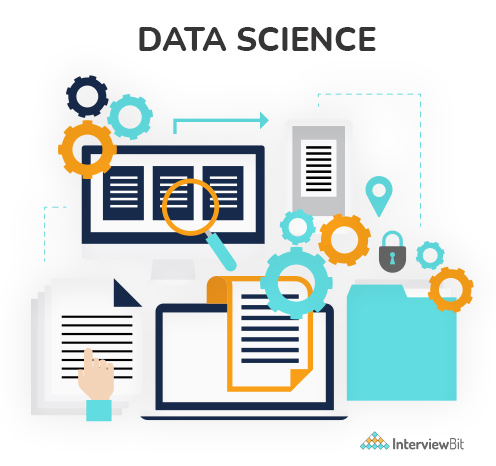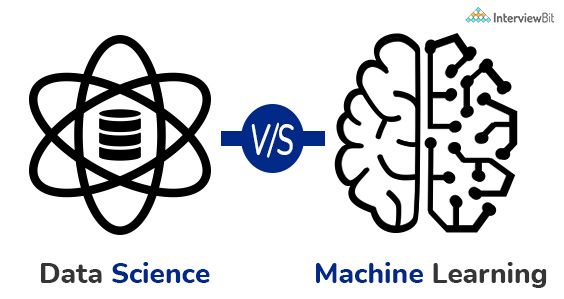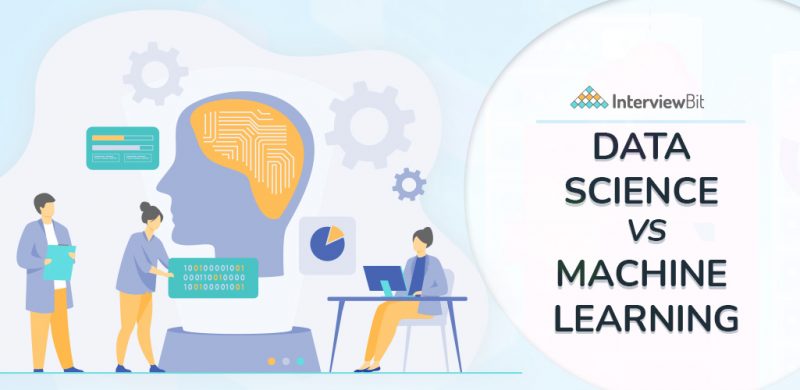- What is Data Science?
- What is Machine learning?
- Skills Required for Data Scientist
- Skills Required for Machine Learning
- 1. Probability and Statistics:
- 2. Data Evaluation and Modeling:
- 3. Aspects of Machine Learning Algorithms:
- 4. Programming Languages:
- 5. Signal Processing Techniques:
- Difference Between Data Science and Machine Learning
- Conclusion
- Frequently Asked Questions
- 1. Which is better, Data Science or Machine Learning?
- 2. Which pays more-Machine Learning or Data Science?
- 3. Can data scientists work in machine learning?
- 4. Is machine learning a good career or data science?
- Additional Resources
After the era of Big Data emerged in the industry of data space in 2010, Organizations had to deal with petabytes and exabytes of data, and therefore, it became very difficult for industries to store and manage the data. In the wake of Hadoop and others solving the storage issue, the focus now shifts to processing the data, where Machine Learning and Deep Learning play a big role. The concepts of data science and machine learning are both under the umbrella of technology and can be used to further the creation and innovation of products, services, infrastructure systems, and much more. Both are high-earning and in-demand careers and pursuing either of them can be rewarding.
Data science is a discipline that studies how data are cleaned, prepared, and analyzed. Furthermore, machine learning is considered to be a branch of artificial intelligence and the subfield of data science at the same time. Data Science vs Machine Learning are closely linked, yet they have distinct functions and objectives that vary from one another. The importance of understanding how these two buzzwords, together with artificial intelligence and deep learning, differ from one another is vital. Specifically, in this article, we will examine the differences between Data Science and Machine Learning and how they are related to one another.

What is Data Science?

Data science, as the name implies, is concerned with data collection and analysis. We may thus describe it as “an area of deep study of data that involves extracting valuable insights from the data and processing that information using a variety of tools such as Jupyter, MATLAB, BigML, Apache Spark, etc., statistical models, and Machine learning algorithms like Linear Regression, Logistic Regression, Decision Tree, etc,” Wikipedia. It is a domain of study concept that is used to manage large amounts of data, and it involves data cleansing, data preparation, data analysis, and data visualization.
Confused about your next job?
A data scientist gathers raw data from various sources, prepares and pre-processes the data, and then uses machine learning algorithms and predictive analysis to derive valuable insights from the data gathered and stored.
Data Collaborative filtering, a technique used by data scientists to make an automatic prediction for a user regarding their interests based on the data collected from various users. For example, Netflix uses this technique to provide better recommendations for search results based on the content that the user has previously watched and the content that is being watched by other users.
Data Scientists must possess a variety of abilities like:
- Skills in programming languages like Python, R, SAS, Scala, and other programming languages.
- Expertise in databases like SQL, MongoDB, and Cassandra.
- Understanding of Machine Learning Algorithms is required.
- And mathematics topics like Statistics, Calculus and Linear Algebra, etc.
- Data mining, cleansing of data, and visualization abilities are required.
- Competencies in the usage of big data technologies such as Hadoop, Apache Spark, Tensor Flow, Data Lakes, etc.
What is Machine learning?

In artificial intelligence (AI), machine learning allows systems to automatically learn from data and predict development on their own without the need to be explicitly designed in advance. The creation of virtual personal assistants, GPS Navigation Services, Social Media services, fraud detection services, chatbots, etc. is plenty of subjects of learning research and development.
We begin the process of learning with observations or data (such as examples, first-hand experience, or teaching) to identify patterns in data and make better choices in the future based on the examples we give. The main goal is to enable computers to learn on their own, without the need for human involvement or help, and to modify their behaviour appropriately.
On the other hand, the text is treated as a series of keywords when employing traditional machine learning algorithms; a semantic analysis method, on the other hand, replicates the human capacity to comprehend the meaning of a text.
The following are the skills required for the Machine Learning Engineer:
- Understanding and putting Machine Learning Algorithms into action are two important skills.
- And a fair understanding of mathematics topics like Multivariate Calculus, Statistics, Discrete Math and Linear Algebra etc.
- Knowledge of various libraries and frameworks such as Natural Language Processing, TensorFlow, Sci-Kit Learn, Theano, Torch, etc.
- Excellent Python or R programming skills are required.
- Detailed understanding of statistical and probability principles
- Data modeling and data assessment skills are required.
Skills Required for Data Scientist
The field of data science focuses on studying data and determining its meaning, while the field of machine learning focuses on understanding and developing methods to improve performance or predict the behaviour of machines. Machine learning falls under the umbrella of artificial intelligence.
The skills required for a data scientist and machine learning scientist include a thorough knowledge of data analysis and excellent programming ability. In addition, they use a diverse variety of skills depending on the needs of the business.
The abilities that make this profession appealing may be divided into two categories:
1. Technical Capabilities:
To be a successful data scientist, you must have strong mathematics, computer science, and statistics background.
Other technical skills that are required are as follows:
- Expertise in machine languages and programming languages, as well as in other programming languages
- An understanding of analytical tools – SAS, Hadoop, Spark, and R are the most often used analytical tools among data scientists.
- Workability of Unstructured Data – The ability to deal with unstructured data that has been collected from a variety of sources.
2. Non-Technical Competencies:
An individual’s skills are categorized as either technical or non-technical in the majority of cases. The names of them are as follows:
- Business acumen that is second to none
- Ability to communicate with others Intuition regarding data
Skills Required for Machine Learning
It is now necessary to discuss machine learning to go ahead in the discussion of the differences between data science and machine learning. A machine learning specialist should have a firm grasp of several fundamental concepts and abilities.
Let’s go through a few of the most important abilities you’ll need.
1. Probability and Statistics:
Your knowledge of theory has a great deal to do with your ability to comprehend algorithmic structures. Hidden Markov templates, Naive Bayes, and Gaussian Mixture are just a few examples of machine learning techniques. If you aren’t familiar with numbers and chance, comprehending these algorithmic structures would not be easy.
2. Data Evaluation and Modeling:
For ML, it is critical to regularly evaluate the effectiveness of different models to preserve the dependability of the measuring technique. To assess the inaccuracy or consistency of a model, a variety of methods such as regression and classification may be employed. You’ll also need an evaluation strategy to go along with it.
3. Aspects of Machine Learning Algorithms:
In order to choose the best machine-learning algorithm for a particular situation, it is critical to understand how different machine-learning algorithms work. Therefore, read up on partial differential equations, gradient descent, quadratic programming, convex optimization, and other related subjects before starting your research project.
4. Programming Languages:
If you want to work in machine learning, you’ll still need to know how to program in languages such as Java, R, Python, and C++, among other things. These programming languages may be used to help you at different stages of your machine-learning project.
5. Signal Processing Techniques:
The feature extraction process is critical to machine learning. Many different signal processing methods, such as bandlets, shearlets, contourlets, and curvelets, will be needed for you over your studies.
Difference Between Data Science and Machine Learning

| Data Science | Machine Learning |
| It is concerned with deciphering and identifying hidden patterns or valuable insights in data that may be used to make more informed business choices in the future. | It is a branch of data science that automatically allows a computer to learn data from data by observing patterns in the data and making decisions without being explicitly programmed and it is becoming more popular. |
| It is used to extract insights from data. | In order to make predictions and categorize the results for fresh data points, it is necessary to utilize this function. |
| In data science, the major steps involved to create a model include extraction of data, cleaning of data, using various tools such as Tableau, Micro Strategy, etc. to analyze essential patterns that are involved, and making a workable model by using algorithms like supervised learning, unsupervised learning, etc., evaluating and deploying the model. | In the context of data science as a whole, the major steps involved to create a machine learning model include collecting the data, visualizing the data, using various machine learning models such as Logical Regression, Bayesian Classifiers, Random Forest, etc., training the dataset, evaluating the dataset and parameter tuning. |
| A data scientist must be knowledgeable in the usage of big data technologies such as Hadoop, Hive, and Pig and statistics and programming in Python, R, or Scala. | Abilities such as computer science basics, programming skills in Python or R, statistics and probability ideas, and so on are required for a Machine Learning Engineer to be successful. |
| It can deal with various types of data, including raw, structured, and unstructured. | Machine Learning mostly relies on structured data to perform its functions. |
| Data scientists invested a significant amount of effort in managing the data, cleaning the data, and identifying patterns in the data. | ML engineers devote a significant amount of their effort to dealing with the complications that arise during the implementation of algorithms and the mathematical ideas that underpin them. |
| A more general phrase for data science is “data processing,” which encompasses not just algorithms and statistics but also the actual processing of the data. | However, it is solely concerned with algorithm statistics. |
| It is a general word that may refer to a variety of fields. | It falls within the category of data science. |
| A large number of data science activities, such as data collection, data cleaning, data processing, and so on. | Unsupervised learning, reinforcement learning, and supervised learning are the three kinds of learning. |
| As an example, Netflix makes use of Data Science technologies. | As an example, Facebook makes use of Machine Learning technologies. |
| Pokémon Go, a game that is built using data science and virtual reality uses the data from Ingress which is a previous application developed by the same company to choose the location of Pokémon. | Pinterest, a platform where users upload their content uses machine learning to provide users with accurate results. |
| Logistics companies like DHL, and FedEx use data science to optimize the delivery process by calculating the suited time to deliver, the best route to deliver, and choosing the cost-effective mode of transport. | Twitter uses a machine learning algorithm to make a decision about displaying tweets on the timeline of users based on their personal interests and preferences of users. |
| There are many operations involved in data science, such as the gathering, cleaning, manipulating, and analyzing of data. | There are three types of machine learning: unsupervised, reinforced, and supervised. |
Conclusion
Data science is a broad, multidisciplinary field that uses the massive amounts of data and computing power available to it to gain a new understanding. Machine learning is one of the most intriguing breakthroughs in current data science, and it has the potential to revolutionize the field. Machine learning is the process by which computers are allowed to learn on their own based on the enormous amounts of data that they are provided with.
These systems have a broad variety of applications, but their capabilities are not inexhaustible. While data science has many advantages, it can only be utilized successfully if you have highly trained employees and high-quality data at your disposal.
Frequently Asked Questions
1. Which is better, Data Science or Machine Learning?
Machine Learning makes use of efficient algorithms that can make use of data without being expressly instructed to do so by the user. Instead, data Science is accomplished via the collection, cleansing, and processing of data in order to extract meaning from it for analytical purposes. However, both data science and machine learning have their own significance and we have great career opportunities in both of the fields.
2. Which pays more-Machine Learning or Data Science?
In India, the average annual pay for a data scientist is Rs.698,412. An entry-level data scientist with less than a year of experience may expect to earn about Rs 36,741,525 per year. The overall pay for a machine learning engineer is between Rs. 7.5 lakh and Rs. 8 lakh per year on average.
3. Can data scientists work in machine learning?
The area of data science draws on computer science fields such as mathematics and statistics. It includes methods such as data mining, cluster analysis, visualization, and machine learning to accomplish its goals.
4. Is machine learning a good career or data science?
It is clear that data science and machine learning are both excellent career choices with many possibilities in both fields. The demand for data scientists and machine learning scientist is ever-growing. So, keep learning and enhance all the skills that are required to be a good data scientist or a good machine learning scientist.
Additional Resources
- Machine Learning Interview Questions
- Data Science MCQ
- Google Data Scientist Salary
- Spotify Data Scientist Salary
- Best Data Science Courses
- Data Science Projects
- Machine Learning Engineer
- Skills Required for Data Scientist
- Data Science vs Data Analytics
- Data Scientist Resume
- Machine Learning Books
- Machine Learning Applications
- Machine Learning Projects







 Join WhatsApp Group
Join WhatsApp Group


